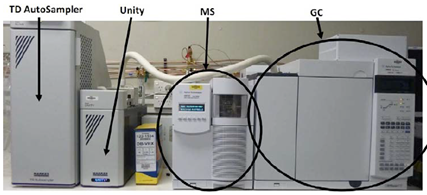VOC analysis using TD-GC-MS
 TD-GC-MS is used for identification and quantification of non-methane volatile organic compounds (NMVOC’s). Thermal desorption (TD) provides analyte pre-concentration; gas chromatography (GC) allow analyte separation; mass spectrometry (MS) provided analyte identification and quantification.
TD-GC-MS is used for identification and quantification of non-methane volatile organic compounds (NMVOC’s). Thermal desorption (TD) provides analyte pre-concentration; gas chromatography (GC) allow analyte separation; mass spectrometry (MS) provided analyte identification and quantification.
The UNSW Odour Lab operates a variety of these systems with varying capabilities for sample preparation (SPME, headspace, sorbent tubes) as well as mass spectroscopy set-ups (single tof, Q-tof, MS/MS).
When coupled with an Odour Detection Port (ODP) it can provide additional functionality of odorant identification and prioritisation within a gas phase sample < See ODP note>
Applications
This method allows the identification and quantification of VOCs from complex mixtures from a variety of sources. Analyses can run as targetted (SIM) or non-targetted (SCAN) depending on study purposes.
VOC emissions from industrial processes, waste management systems, consumer products and packaging, food products, ambient conditions among others have been analysed.
To find out more about these methods and potential applications, get in touch with Odour@unsw.edu.au
Relevant Publications
Fisher RM; Le-Minh N; Sivret EC; Alvarez-Gaitan JP; Moore SJ; Stuetz RM, 2017, 'Distribution and sensorial relevance of volatile organic compounds emitted throughout wastewater biosolids processing', Science of the Total Environment, vol. 599-600, pp. 663 - 670, http://dx.doi.org/10.1016/j.scitotenv.2017.04.129
Sivret E.C., Wang B., Parcsi G., Stuetz R.M. 2016, Prioritisation of odorants emitted from sewers using odour activity values. Water Research 88, 308 – 321 https://doi.org/10.1016/j.watres.2015.10.020
Murphy K.R., Parcsi G., Stuetz R.M. 2014, Non-methane volatile organic compounds predict odor emitted from five tunnel ventilated broiler sheds. Chemosphere 95, 423 – 432 https://doi.org/10.1016/j.chemosphere.2013.09.076




